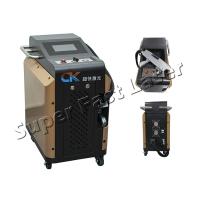Specialized Metal Surface Dirty Stains Laser Cleaner Machine Rust
Cleaning Laser Device
Main Technical Parameters
Item | L/N | Characteristics | Test Conditions | Min. | Typical | Max. | Unit |
Electrical Characteristics | 1 | Power Voltage | 220 | 210 | 220 | 230 | AC |
2 | Maximum current loss | Pout=Pnom | 4 | 5 | 6 | A |
3 | Total Power | 600 | 590 | 600 | 610 | W |
4 | Fiber Cable | 5 | 5 | 5 | 10 | M |
General Characteristics | 1 | Working temperature range | 0 | / | 60 | ℃ |
2 | Storage temperature | -10 | / | 60 | ℃ |
3 | Laser power | 100 | W |
4 | Peak power | >10KW | KW |
5 | Cooling method | Air Cooling | |
6 | Laser level | 4 Class | |
7 | Pulse energy | 1.5mJ | mJ |
8 | Laser wavelength | 1064 | nm |
9 | Preheat time | Reach to start operation | 0 | s |
Achieve complete stability | 10 |
10 | Humidity | 10 | / | 95 | % |
11 | Laser machine size | L647*W440*H859 | mm |
12 | Weight | 70 | kg |
Principles and Fundamentals of Fiber Laser Cleaning
Laser cleaning is now getting to be a more and more important
process for many industries all around the world, and while it has
similarities to other laser processes, it has some unique
attributes which set it apart. We have covered these below.
The basics
Before examining the specifics in more detail, these are the basic
principles and fundamentals of fiber laser cleaning:
· It is a non-contact, non-abrasive process
· It is a process completed using a fiber laser, as opposed to a
crystal or gas laser
· It allows users a great deal of control over power output,
wavelength and ablation depth
· It is a newer cleaning process, replacing more traditional
methods such as media blasting, dry-ice blasting or cleaning using
chemical solvents
· It is an efficient, safe, environmentally-friendly and
cost-effective process
· It is a more efficient cleaning method compared with the
traditional cleaning way.
Application
Metal surface rust removal, Surfacepaint removal and paint
treatment, Surfaceoil, stains, dirt cleaning, Surface coating,
clear coating, Weldingsurface / spray surface pretreatment,
Stonesurface dust and attachment removal, Rubber mold residue
cleaning.
A Metal surface cleaning
B Removal paint of metal surface
C stains cleaning on the surface
D Surface coating cleaning
E Pre-treatment of welding surface cleaning
F Stone surface cleaning
G Rubber mold residue cleaning
Advantages
1.. non-contact cleaning, does not damage the part substrate.
2.. precise cleaning, can achieve a precise location, the exact
size of the selective cleaning.
3.. laser-cleaning-machine without any chemical cleaning fluid, no
supplies, safety and environmental protection.
4.. simple operation, power can be hand-held or with the robot to
achieve automated cleaning.
5.. cleaning efficiency is very high, save time.
6.. laser cleaning system is stable, almost no maintenance.
Why is the laser cleaning process better than more traditional
methods?
Firstly, other methods were contact processes, it means they were
abrasive and damaging to the materials that they were working with.
Take media blasting, for example, which essentially acts as a
pressure washer, but with pressurized air, to blast a material
until it is clean. It gets the job done, but it often affects the
material that you don’t want to damage below!
Laser cleaning, on the other hand, is non-contact and non-abrasive,
and so will only irradiate the material that you want to get rid
of.
You also have a great deal of control over the beam, meaning you
can achieve the desired depth that you want to. Further to this,
you can irradiate the whole surface layer of a material, or a much
thinner layer, say the topcoat of paint, but not the primer below.
Or, should you wish, you can just clean a very small section. If
using another process which simply blasts the material, it is hard
to enjoy such a high level of control.
One of the key benefits in the way that laser cleaning works is
that not much waste is left over due to the irradiation process;
the substrate is simply vaporized rather than left as waste. The
majority of the waste that is leftover comes as dust particles and
can be easily collected and removed by the user.
Previous processes left a great deal of waste that had to be
removed. Not only is this costly in terms of time efficiency, but
much of this waste was hazardous as well, and users were often
required to wear protective gear. This danger to worker safety has
been removed by the laser.
So, the key characteristics of how the laser cleaning process
works, which differentiates it from more traditional methods, are
that:
• It is a much safer process
• It is more efficient
• It offers the user a higher level of accuracy and control and
• There is a greater focus on a higher quality end result









